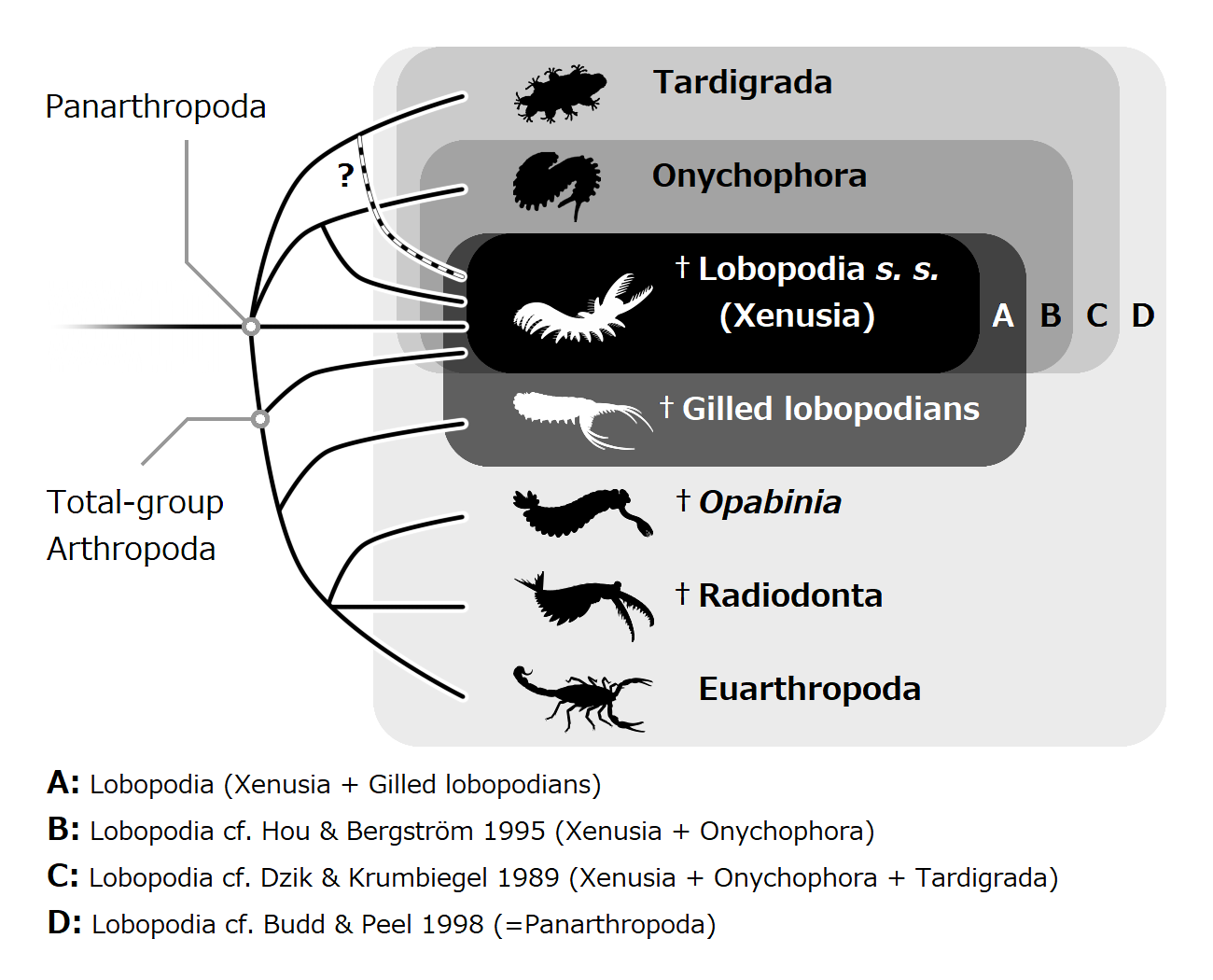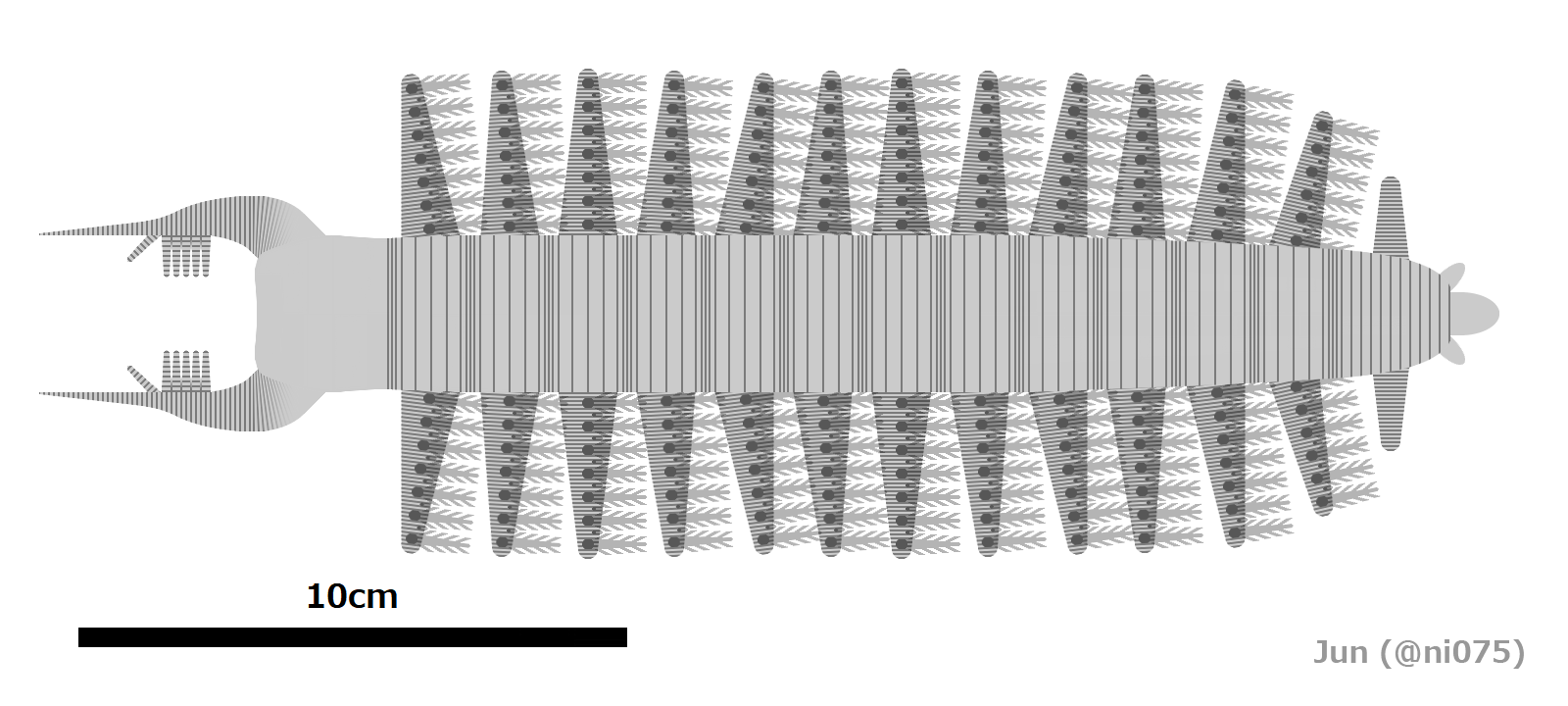|
Megadictyon
''Megadictyon'' is a genus of Cambrian lobopodian with similarities to ''Jianshanopodia'' and '' Siberion''. The name of the genus is occasionally mis-spelt as ''Magadictyon''. Description ''Megadictyon'' is a large lobopodian, with a body length (excluding appendages) possibly up to 20 centimeters in total. The head has a pair of robust frontal appendages associated with rows of spines and terminal claws. Located on the underside of the head is a radiodont-like mouthpart formed by multiple layers of plates and tooth-like structures. The trunk is wide and annulated, with a pair of well-developed lobopodous limbs on each body segment. Only 8 segment/limb pairs are countable in the incomplete fossil materials which are lacking the posterior region, so it may have had more (possibly up to 11 to 13) in nature. It also has pairs of digestive glands similar to those of basal arthropod Arthropods ( ) are invertebrates in the phylum Arthropoda. They possess an arthropod exoskele ... [...More Info...] [...Related Items...] OR: [Wikipedia] [Google] [Baidu] |
Lobopodian
Lobopodians are members of the informal group Lobopodia (), or the formally erected phylum Lobopoda Cavalier-Smith (1998). They are panarthropods with stubby legs called lobopods, a term which may also be used as a common name of this group as well. While the definition of lobopodians may differ between literatures, it usually refers to a group of soft-bodied, marine worm-like fossil panarthropods such as ''Aysheaia'' and ''Hallucigenia''. However, other genera like ''Kerygmachela'' and ''Pambdelurion'' (which have features similar to other groups) are often referred to as “gilled lobopodians”. The oldest near-complete fossil lobopodians date to the Lower Cambrian; some are also known from Ordovician, Silurian and Carboniferous Lagerstätten. Some bear toughened claws, plates or spines, which are commonly preserved as small carbonaceous fossil, carbonaceous or Small Shelly Fossils, mineralized microfossils in Cambrian strata. The grouping is considered to be paraphyletic, as ... [...More Info...] [...Related Items...] OR: [Wikipedia] [Google] [Baidu] |
Lobopodia
Lobopodians are members of the informal group Lobopodia (), or the formally erected phylum Lobopoda Cavalier-Smith (1998). They are panarthropods with stubby legs called lobopods, a term which may also be used as a common name of this group as well. While the definition of lobopodians may differ between literatures, it usually refers to a group of soft-bodied, marine worm-like fossil panarthropods such as '' Aysheaia'' and '' Hallucigenia''. However, other genera like '' Kerygmachela'' and '' Pambdelurion'' (which have features similar to other groups) are often referred to as “gilled lobopodians”. The oldest near-complete fossil lobopodians date to the Lower Cambrian; some are also known from Ordovician, Silurian and Carboniferous Lagerstätten. Some bear toughened claws, plates or spines, which are commonly preserved as carbonaceous or mineralized microfossils in Cambrian strata. The grouping is considered to be paraphyletic, as the three living panarthropod groups (A ... [...More Info...] [...Related Items...] OR: [Wikipedia] [Google] [Baidu] |
Radiodonta
Radiodonta is an extinct Order (biology), order of stem-group arthropods that was successful worldwide during the Cambrian period. Radiodonts are distinguished by their distinctive frontal appendages, which are morphologically diverse and were used for a variety of functions. Radiodonts were among the earliest large predators, but they also included sediment sifters and filter feeders. Some of the most famous species of radiodonts are the Cambrian taxa ''Anomalocaris, Anomalocaris canadensis'', ''Hurdia, Hurdia victoria'', ''Peytoia nathorsti'', ''Titanokorys gainesii, Titanokorys gainesi, Cambroraster, Cambroraster falcatus'' and ''Amplectobelua, Amplectobelua symbrachiata''. The later surviving members include the subfamily Aegirocassisinae from the Early Ordovician of Morocco and the Early Devonian member ''Schinderhannes bartelsi'' from Germany. Etymology The name Radiodonta (Latin for ''radius'' "spoke of a wheel" and Greek for ''odoús'' "tooth") refers to the radial arrang ... [...More Info...] [...Related Items...] OR: [Wikipedia] [Google] [Baidu] |
Siberiida
Siberiidae is a family of Cambrian lobopodians, sometimes called "jianshanopodians" or "giant lobopodians". Morphology Siberiids often reach large sizes, achieving as much as 22 cm, or even over 30 cm in length as seen in ''Jianshanopodia''. Cephalon The anterior of the Cephalon (arthropod head), cephalon is blunt, prominent appendages equipped with Arthropod leg, endites protrude laterally from it. In the case of ''Megadictyon'' the appendages terminate with sclerotized spines. The bottom of the head exposes an oral opening surrounded by an array of layers of plates and teeth which has been compared to the oral cones of Radiodonta, radiodonts; the pharynx houses numerous pharyngeal teeth, and has been compared to that of Priapulida, priapulids. No eyes have been observed. Limbs Siberiids bear stout, unarthropodized, annulated limbs called lobopods. They bear gill-like papillae protruding dorsally from the series of annuli; These papillae were weakly sclerotized ... [...More Info...] [...Related Items...] OR: [Wikipedia] [Google] [Baidu] |
Pambdelurion
''Pambdelurion'' is an extinct genus of Panarthropoda, panarthropod from the Cambrian aged Sirius Passet site in northern Greenland. Like the morphologically similar ''Kerygmachela'' from the same locality, ''Pambdelurion'' is thought to be closely related to arthropods, combining characteristics of "lobopodians" with those of primitive arthropods. Description ''Pambdelurion'' was large for a Cambrian animal, and is estimated to have reached a length of . ''Omnidens'', an organism from China that closely resembles ''Pambdelurion'' and may even be synonymous with it, reached even larger sizes, estimated to be based on the proportions of ''Pambdelurion''. The head of ''Pambdelurion'' bore a large pair of frontal appendages, homologous to the antennae of onychophorans and frontal appendages of Radiodonta, radiodonts. These frontal appendages were weakly muscled and relatively soft, suggesting they may have served primarily as sensory organs, rather than for grasping prey. Between ... [...More Info...] [...Related Items...] OR: [Wikipedia] [Google] [Baidu] |
Deuteropoda
Deuteropoda is a proposed clade of Arthropoda, arthropods whose members are distinguished from more Basal (phylogenetics), basal stem-group arthropods like Radiodonta, radiodonts by an anatomical reorganization of the head region, namely the appearance of a differentiated first appendage pair (the 'Deutocerebrum, deutocerebral' pair), a multisegmented head, a Hypostome (trilobite), hypostome/Labrum (arthropod mouthpart), labrum complex, and by bearing pairs of segmented biramous (two branched) limbs. The clade contains all living Arthropoda, arthropods (i.e. Chelicerata, chelicerates and Mandibulata, mandibulates) as well as several fossil groups that share these characteristics (e.g. Fuxianhuiida, Megacheira, Isoxyida, and Artiopoda), while excluding other fossil groups that are more 'basal' or 'primitive' (e.g. radiodonts, Opabiniidae, opabiniids and Lobopodia, lobopodians). Members of Deuteropoda that are Basal (phylogenetics), basal to the last common ancestor of chelicerates ... [...More Info...] [...Related Items...] OR: [Wikipedia] [Google] [Baidu] |
Jianshanopodia
''Jianshanopodia ''is a monotypic genus of Cambrian lobopodian, discovered from Maotianshan Shales of Yunnan, China. Description ''Jianshanopodia'' resemble the closely-related siberiid ''Megadictyon''. The head possess a pair of frontal, grasping appendages bear wedge-shaped plates. The pharynx was surrounded by rows of denticles, resembles those of radiodonts and priapulids. The trunk was annulated and possesses a pair of stout legs (lobopods) per body segment. Due to the lack of a complete specimen, the exact number of body segments/leg pair is uncertain. If 12 body segments present, the living animal might grew over 20 cm. Each of the leg was lined up with rows of tubercles and tree-like branches, instead of being tipped with claws as many lobopodians are. The trunk terminated with a large median lobe and a pair of small lateral lobes, forming a fan-like structure. Inside the trunk was a sediment-filled gut surrounded by serially repeated diverticulae. ''Jianshanopo ... [...More Info...] [...Related Items...] OR: [Wikipedia] [Google] [Baidu] |
Aegirocassis
''Aegirocassis'' is an extinct genus of giant radiodont arthropod belonging to the family Hurdiidae that lived 480 million years ago during the early Ordovician in the Fezouata Formation of Morocco. It is known by a single species, ''Aegirocassis benmoulai''. Van Roy initiated scientific study of the fossil, the earliest known of a "giant" filter-feeder discovered to date. ''Aegirocassis'' is considered to have evolved from early predatory radiodonts. This animal is characterized by its long, forward facing head sclerite, and the endites on its frontal appendages that bore copious amounts of baleen-like auxiliary spines. This animal evolving filter-feeding traits was most likely a result of the Great Ordovician Biodiversification Event, when environmental changes caused a diversification of plankton, which in turn allowed for the evolution of new suspension feeding lifeforms. Alongside the closely related '' Pseudoangustidontus'', an unnamed hurdiid from Wales, the middle Ordovi ... [...More Info...] [...Related Items...] OR: [Wikipedia] [Google] [Baidu] |
Arthropod
Arthropods ( ) are invertebrates in the phylum Arthropoda. They possess an arthropod exoskeleton, exoskeleton with a cuticle made of chitin, often Mineralization (biology), mineralised with calcium carbonate, a body with differentiated (Metamerism (biology), metameric) Segmentation (biology), segments, and paired jointed appendages. In order to keep growing, they must go through stages of moulting, a process by which they shed their exoskeleton to reveal a new one. They form an extremely diverse group of up to ten million species. Haemolymph is the analogue of blood for most arthropods. An arthropod has an open circulatory system, with a body cavity called a haemocoel through which haemolymph circulates to the interior Organ (anatomy), organs. Like their exteriors, the internal organs of arthropods are generally built of repeated segments. They have ladder-like nervous systems, with paired Anatomical terms of location#Dorsal and ventral, ventral Ventral nerve cord, nerve cord ... [...More Info...] [...Related Items...] OR: [Wikipedia] [Google] [Baidu] |
Peytoia
''Peytoia'' is a genus of hurdiid radiodont, an early diverging order of stem-group arthropods, that lived in the Cambrian period, containing two species, ''Peytoia nathorsti'' from the Miaolingian of Canada and '' Peytoia infercambriensis'' from Poland, dating to Cambrian Stage 3. Its two frontal appendages had long bristle-like spines, it had no fan tail, and its short stalked eyes were behind its large head. 108 specimens of ''Peytoia'' are known from the Greater Phyllopod bed, where they comprise 0.21% of the community. ''Peytoia nathorsti'' and its junior synonym ''Laggania cambria'' played a major role in the discovery of the radiodont body plan. Initially interpreted as a jellyfish and a sea cucumber respectively, they were eventually shown to be the mouthparts and body of a single animal, which bore ''Anomalocaris''-like appendages. ''Peytoia infercambriensis'' is the geologically oldest known radiodont species. Classification ''Peytoia'' belongs to the clade Hurd ... [...More Info...] [...Related Items...] OR: [Wikipedia] [Google] [Baidu] |
Utaurora
''Utaurora'' is an extinct genus of opabiniid, which were bizarre stem-arthropods closely related to true arthropods and radiodonts; the type species is ''U. comosa''. The animal's fossils come from the Cambrian of Utah. This genus is so far the only other known unquestionable opabiniid, with the other being ''Opabinia'' itself. There are other animals like '' Myoscolex'' and '' Mieridduryn'' that could be opabiniids, but the classification of those two genera is still debated. History of study The holotype specimen of ''Utaurora comosa'', KUMIP 314087, was collected from the Wheeler Formation in Utah. It was initially described as a specimen of ''Anomalocaris'' in 2008. In 2022, Pates ''et al.'' reinterpreted the specimen as an opabiniid and described it as a new genus and species. Etymology ''Utaurora'' is a portmanteau of Utah, in reference to where the specimen was found, and Aurora, the name of a Roman goddess. The reference to Aurora was chosen as she is a goddess of t ... [...More Info...] [...Related Items...] OR: [Wikipedia] [Google] [Baidu] |









